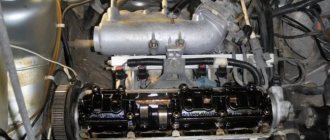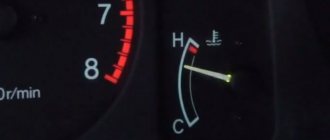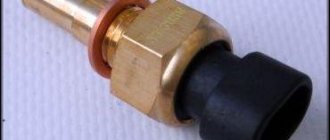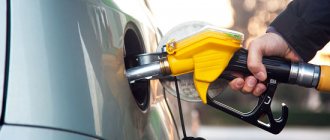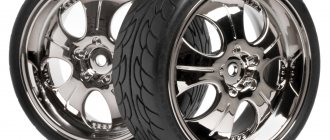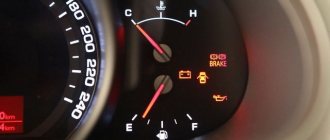The stability of any vehicle depends on the operating conditions and technical characteristics of the internal combustion engine. An indicator such as engine operating temperature depends not only on environmental conditions, but also on many operational factors. If this parameter corresponds to the calculated value, i.e. is within the acceptable range, the power unit provides maximum energy output for a long time. Optimal operating conditions of the internal combustion engine create the best conditions for the functioning of all vehicle systems.
What should be the operating temperature of the engine?
When fuel mixtures burn in the engine cylinders, a huge amount of heat is released. In the combustion chambers the temperature reaches more than 2000°C. The design of the power units includes a cooling system, the elements of which remove heat from the working units. Thanks to the efficient operation of the internal combustion engine cooling system elements, the thermal regime is maintained within optimal limits from +80 to 90°C. There are certain types of motors for which the standards have been extended to 110°C, most often these are air-cooled mechanisms.
When the engine operates at optimal temperature conditions, the best conditions are created for:
- Complete filling of cylinders with air-fuel mixtures.
- Stable operation of the power unit while driving.
- Reliable operation of vehicle mechanisms and systems.
What does overheating mean?
Too high an engine temperature can be caused by breakdowns of the cooling system elements or contamination of its jacket.
Why does the temperature rise
The most common problem can be considered a lack of coolant, which should effectively remove heat from very hot parts. In such situations, it is better to add antifreeze. If this is not possible, then it is recommended to turn on the interior heating to remove excess heat.
The problem may occur due to a breakdown of the electric fan. Here the contacts may oxidize, the relay may burn out, or the sensor may break. For diagnostics, you can remove the connectors from the fan and connect them directly to the battery.
The engine temperature may increase due to a thermostat failure when the coolant circulates only in a small circle inside the engine itself. Overheating can also occur due to a clogged cooling system, a breakdown of the cylinder head gasket, or improper closing of the radiator shutters in warm weather.
Possible consequences
If overheated, the engine may seize. This is caused by boiling and evaporation of the coolant. For this reason, the metal expands, the parts are deformed, changing the normal dimensions and shape of the parts that move.
The maximum heating level is determined by the type and properties of antifreeze. In addition, due to overheating, the radiator may collapse and electrical wiring may melt.
Deviations from the norm in temperature conditions of power units
Temperature readings inside the engine can be seen on a device located in the interior of any modern car.
What does exceeding the normal operating temperature in the engine cause? At ultra-high temperatures, the technological thermal clearances of metal elements are violated. This causes the following negative changes in the operation of the power unit:
- accelerated wear of working units and parts;
- deformations and breakdowns of mechanisms;
- reduction in engine power;
- occurrence of detonation;
- unauthorized ignition of fuel.
What does the concept of low engine temperature mean? If, while the car is moving, the gauge needle is below the recommended temperature level, there are good reasons for alarm. The unheated fuel-air mixture condenses and settles on the cylinder walls. When condensation enters the oil pan, the engine oil dilutes. The technical properties and characteristics of the lubricant deteriorate sharply. During prolonged operation in low thermal conditions, the components and parts of the power unit quickly wear out and become unusable.
Reasons for rising temperature
Structurally, the engine has thermal clearances, since parts are subject to expansion when heated. If the temperature of the power unit rises above permissible values, the clearances are violated, which causes intense wear, scuffing and various types of breakdowns. In addition, there is a decrease in engine power due to deterioration in cylinder filling, as well as the appearance of detonation and self-ignition of the fuel.
Overheating can occur due to:
- Thermostat valve stuck closed
- Malfunction of the electric radiator cooling fan (breakage of the electric motor, blown fuse, failure of the temperature sensor or fluid coupling)
- Radiator contamination
- Malfunction of the valve in the expansion tank cap
- Cylinder block gasket failure
- Pump leaks
- Loss of tension or breakage of the drive belt of additional mechanisms
- Depressurization of the cooling system
Gasoline engine operating temperature
The operation of each internal combustion engine is accompanied by the release of heat. The working elements of the motor operate under high temperature conditions.
When lowering the piston to the lowest point, a large amount of energy is expended, and at the same time heat is released. Elements of power units are made of metal. As you know, when heated, this material expands. In the manufacture of engine components and parts, special thermal gaps are provided, designed to heat the products to optimal values. To prevent jamming, the engine design includes an engine cooling system.
What is the optimal operating temperature for a gasoline engine? The operating temperature of gasoline power units, both carburetor and injection, should not exceed +90°C. The coolant's job is to maintain a constant engine temperature at the proper level.
Interesting: There is a concept of “dangerous engine temperature”. For gasoline-type internal combustion engines it is 130°C. After reaching the limit values, jamming of the power unit elements may occur.
Important: After turning on the engine and further moving the vehicle, the operator constantly monitors the operating temperature of the internal combustion engine. Deviations indicate problems in the cooling system:
- An increase in temperature in a gasoline engine leads to boiling and rapid evaporation of the coolant.
- As its quantity decreases, the engine temperature will rapidly increase.
- Under the influence of high temperatures, the metal will begin to deform and expand in volume.
- The dimensions of the parts will be greatly changed.
- As a result, the motor will jam.
To restore the performance of such an engine will require an expensive overhaul of the vehicle.
Engine takes a long time to warm up
This is another issue that is very subjective. What do you mean it takes a long time to warm up?
Let's say 20 minutes is a lot or normal? I often hear this exact number when complaining about long warm-up times. Why do people think it takes so long? Are there any standards or regulations and it is clearly written there that the engine must complete, say, 17.5 minutes?
Personally, I have never seen anything like this. And all because the heating conditions are different - coolant temperature, ambient temperature, wind speed, whether the interior heater is on. Whether the car is moving or not. And if it moves, then at what speed? What engine speed, etc.
Therefore, the warm-up time will always be different and I cannot say specifically that 20 minutes is a lot.
But I can only give some average values so that you can at least roughly start from something.
Hundreds of engine management system diagnostic files pass through me every month. Therefore, it is possible to build approximate values over several years.
So here it is:
- From 10 degrees to operating temperature, warming up takes about 10 minutes. Warm up for one minute and then drive at an average speed of 40 km/h in the city.
- From 0 degrees to operating temperature in about 18 minutes. Warm up for six minutes and then drive at an average speed of 30 km/h.
Warming up outside. In a garage, the warm-up time is slightly reduced.
From these average figures we can conclude that if you have minus ten degrees, there is a strong wind and your car is coasting downhill, then 20 minutes is still a quick warm-up
Therefore, draw conclusions and do not interfere with the machine’s work.
What causes engine overcooling?
The phenomenon of hypothermia also negatively affects the quality of operation of the power unit. Most often this happens in winter or when operating a vehicle in difficult climatic conditions of the far north.
The operating temperature of the engine in winter can be sharply reduced while the car is moving. At the same time, flows of cooled air blow over the radiator and the entire power unit. As a result, the coolant sharply lowers the engine temperature, even if it is running at full load.
Differences by engine type
There are different models, the temperature conditions of which will be different. For example, there are regular motors and forced ones, the second type heats up more. The combustion processes in them occur differently, so the thermostat valve operates at different times. In addition, different models have different cooling systems that operate at a specific speed and intensity.
The moment the electric fan turns on depends on how the temperature sensor is configured and when it is triggered. Please note that car models with an injector and a carburetor have different settings, and a thermostat, even for the same car, but with a different power system, requires its own. This device directly affects the heating of the engine, so the choice in case of replacement requires special attention.
Diesel engine operating temperature
Maintaining the operating temperature of a diesel engine is a necessary condition for the optimal functioning of vehicle mechanisms and systems. The operating principle of a diesel engine is fundamentally different from a gasoline engine. Here the fuel mixture is not prepared in advance. Air enters the chamber first. With strong compression, the air mass heats up to +700°C. At the moment of fuel injection, an explosion occurs, followed by uniform combustion of the resulting mixture. As a result, the piston moves to bottom dead center.
Diesel temperature depends on the following factors:
- motor type;
- ignition delay period of the air-fuel mixture;
- quality, uniformity of fuel combustion.
It is believed that the optimal operating temperature of the engine should be in the range of 70 – 90°C. The permissible maximum for diesel power units operating under heavy loads is +97°C, no more.
Advice: If the diesel engine is in good condition, it is recommended to warm up the coolant to a temperature of at least +40°C before driving. In severe frosts outside the car, the engine may begin to warm up only when driving. At first, it is recommended to engage a lower gear. In the future, the load on the engine should increase gradually, only after the temperature rises to at least 80°C.
Consequences of engine overheating
Almost everyone knows the danger of overheating a motor unit. First of all, this always leads to the fact that the liquid not only begins to boil intensely, but also evaporates.
When the system is completely freed from the presence of the liquid component, the cooling process completely stops. The temperature rises quite quickly in such cases.
- The engine, overheating, promotes expansion, as well as a mandatory change in the properties present in the metal at the permissible temperature.
- A process begins that ultimately leads to the fact that, due to the resulting deformation of individual parts, their usual normal dimensions change.
- They just end up jamming. A situation arises when it becomes impossible to make do with conventional repairs, and more expensive intervention from a qualified specialist is required.
If we talk about the modern generation of cars, then almost all of them have such a critical mark corresponding to one hundred and thirty degrees Celsius. The engine seizes precisely when this level is reached.
Depending on the properties of the liquid used for cooling, the maximum permissible temperature values for a particular case are determined.
Water, for example, boils when the temperature level is one hundred degrees, but antifreeze can boil at different temperatures, ranging from one hundred eight to one hundred thirty-eight degrees.
All values are given in Celsius. This is the reason why a number of motors can safely operate at temperatures of one hundred and twenty degrees.
Using water as a cooling medium
The use of water to cool the power plant in winter is not recommended, but is allowed. The system must be filled with already heated water to avoid difficult starting of the engine with increased wear of parts. The radiator and motor must be insulated. Heated water must be poured with the drain valves open several times. Then close the taps, fill the system and start starting.
After the end of the trip, the liquid must be drained when it cools down to 45-50 degrees. If you empty the system immediately upon arrival, cracks and other defects may appear. Leaving the water system in frosty conditions is unacceptable. When freezing, the liquid will expand and render the engine, radiator and other components unusable.
Accepted norm
Generally speaking, the operating temperature should not remain constant. When the engine is turned off and the car has stood motionless for at least several hours, the antifreeze has warmed up to approximately room temperature. This indicator is not the norm, and therefore the internal combustion engine must be warmed up before driving.
How can you understand that the motor has fully assumed working condition and is ready for further movement? This, of course, is evidenced by the device, which has a small pictogram with a thermometer at the bottom of the scale. The markings of its scale, as a rule, vary from 50 to 130 degrees - this interval, with some margin in both directions, centers around the normal coolant temperature indicator. The norm, by the way, is 90 degrees - this is equally true for cars, trucks and any other types of vehicles.
It is quite possible that even after a long period of movement the temperature has not become normal, but is, say, 60–80 degrees. This can happen for two reasons. The first of them is that the device or temperature sensor is faulty, so their readings simply do not coincide with the real ones. The problem, as a rule, is solved by diagnostics from specialists and replacement of inexpensive and rather primitive functional elements and sensors.
The second reason is extreme cold, which does not allow a running engine to warm up to the required temperatures. The fact is that coolant constantly circulates from the internal combustion engine to the radiator, and this process does not stop during operation. In this regard, in some cases, even when the fan is turned off, the antifreeze remains insufficiently heated, and the motor does not reach the required temperatures.
Main types of internal combustion engine cooling systems
- Natural type air system. It is still used in mopeds and inexpensive motorcycles.
- Forced air system . For more efficient cooling, an additional electric fan is used.
- Open type liquid cooling. It is used in river and sea vessels where it is possible to replenish with cold water.
- Closed-loop liquid cooling . Used in most modern cars with internal combustion engines.
You are not striving enough to realize yourself
You can ask a fair question: what does self-realization have to do with it? It's simple: activities that you like, your hobbies, are what you can use to realize yourself.
No matter what we strive to achieve in life, it is how much we want to achieve our goals that ultimately becomes the deciding factor in achieving them. Unfortunately, too many people try to limit their desires and tell themselves and others that they don't need incredible success.
However, such thinking is dangerous. When we limit the scope of our desires, we put barriers to what we are willing to do to achieve our goals and success in life. When this happens, we limit the scope of our motivation and interest in any particular activity and overall sense of satisfaction.
Lack of interesting and desirable goals can easily reduce our motivation and make us feel like nothing interests us.
Which lubricant to choose?
Expensive cars have certain requirements for lubricants. In addition, they react very sharply to changes in the environment and operating conditions. Therefore, the following rules should be observed:
- Use only the lubricant recommended by your vehicle manufacturer. Information about such a lubricant can be found in the book attached to the machine.
- Oil changes must be carried out in a timely manner and taking into account environmental conditions. Even if the time has not come to change the lubricant, but the mileage has exceeded the norm, it is worth contacting a service center or spending time doing everything yourself.
- It is necessary that the working area of the motor is well ventilated, this will prevent overheating of the working parts.
- The cooling system must work properly and also meet the operating conditions of the car.
- Periodically check the oil level in the system, since it is precisely by the high consumption of lubricating fluid that you can notice the presence of problems with the engine.
- When analyzing a lubricant, the sequence of actions must be strictly followed to avoid inaccuracies.


